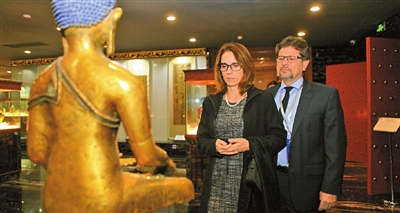
Representatives to the UNESCO High-level Forum on Museums observe a gilded bronze statue of the Buddha dating back to the Yuan Dynasty (1271-1368) at the Shenzhen Zhizheng Art Museum on Thursday. Lao Sun
Zhang Yang
nicolezyyy@163.com
A seminar highlighting cross-border collaboration among museums was held yesterday at the Wuzhou Guest House in Futian District, which is a parallel event to the three-day UNESCO High-level Forum on Museums to wrap up in Shenzhen today.
Gong Liang, director of the Nanjing Museum in Jiangsu Province, said cooperating with other museums to host exchange exhibitions is an efficient way to keep visitors coming back to his museum.
“One frequent visitor went to our museum eight times last year because we had different exchange exhibitions rotating in and out,” he said.
Gong also mentioned that despite the rapidly increasing number of museums in China, many Chinese museums are facing a shortage of collections and professional talent, making it necessary for museums to engage in more intensive domestic and cross-border collaborations.
According to Gong, museums should also consider the taste of local communities when curating exhibitions. “People in developed regions in China are fond of elegant and stylish things, but people in rural areas prefer things imbued with strong emotion,” he said. “This is reflected in the trends of wedding gowns. For example, urbanites are willing to wear white wedding gowns but brides in rural villages are always dressed in red.”
Eiji Mizushima, a professor from University of Tsukuba in Japan, said he has traveled to Libya once or twice per year since 2007 to offer on-site training to museum professionals in Libya.
He highly values the role of museum professionals in keeping a museum alive and appealing to visitors. “Without human resources, a museum is empty,” he said.
The first International Training Center for Museum Professionals was set up at the Palace Museum in Beijing by the International Council of Museums in 2013. But Mizushima said the training program is too short and it needs to be strengthened, and he also called on the establishment of a permanent institution for high level museum professionals in the global scope.
Another guest speaker, Luisa Elena Mengoni, is the head of the V&A Gallery. The gallery located in Shekou was jointly built by the Victoria and Albert Museum in Britain and Design Society, a cultural organization under China Merchants Shekou (CMSK).
Mengoni said the museum’s cooperation with CMSK is a two-way relationship that enables both sides to share professional expertise, collections, networks and academic findings.
Editor: Jane Chen